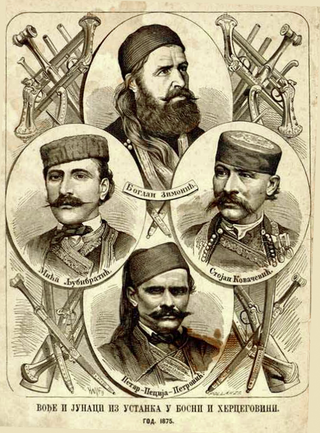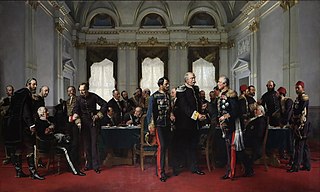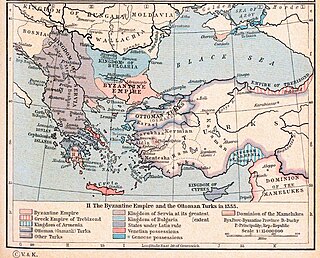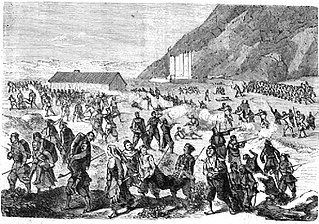
Austria-Hungary, also referred to as the Austro-Hungarian Empire, the Dual Monarchy or the Habsburg Monarchy, was a multi-national constitutional monarchy in Central Europe between 1867 and 1918. A military and diplomatic alliance, it consisted of two sovereign states with a single monarch who was titled both Emperor of Austria and King of Hungary. Austria-Hungary constituted the last phase in the constitutional evolution of the Habsburg monarchy: it was formed with the Austro-Hungarian Compromise of 1867 in the aftermath of the Austro-Prussian War, following wars of independence by Hungary in opposition to Habsburg rule. It was dissolved shortly after Hungary terminated the union with Austria in 1918.

Bosnia and Herzegovina is a country in Southeast Europe on the Balkan Peninsula. It has had permanent settlement since the Neolithic Age. By the early historical period it was inhabited by Illyrians and Celts. Christianity arrived in the 1st century, and by the 4th century the area became part of the Western Roman Empire. Germanic tribes invaded soon after, followed by Slavs in the 6th century.

Đorđe Petrović, known by the sobriquet Karađorđe, was a Serbian revolutionary leader who led a struggle against the Ottoman Empire during the First Serbian Uprising. He held the title of Grand Vožd of Serbia from 14 February 1804 to 3 October 1813.

The Herzegovina uprising was an uprising led by the Christian Serb population against the Ottoman Empire, firstly and predominantly in Herzegovina, from where it spread into Bosnia and Raška. It broke out in the summer of 1875, and lasted in some regions up to the beginning of 1878. It was followed by the Bulgarian Uprising of 1876, and coincided with Serbian-Turkish wars (1876–1878), all of those events being part of the Great Eastern Crisis (1875–1878).

The Congress of Berlin was a diplomatic conference to reorganise the states in the Balkan Peninsula after the Russo-Turkish War of 1877–1878, which had been won by Russia against the Ottoman Empire. Represented at the meeting were Europe's then six great powers: Russia, Great Britain, France, Austria-Hungary, Italy, and Germany; the Ottomans; and four Balkan states: Greece, Serbia, Romania and Montenegro. The congress concluded with the signing of the Treaty of Berlin, replacing the preliminary Treaty of San Stefano which had been signed three months earlier.

The Military Frontier was a borderland of the Habsburg monarchy and later the Austrian and Austro-Hungarian Empire. It acted as the cordon sanitaire against incursions from the Ottoman Empire.
Sarajevo is a city now in Bosnia and Herzegovina.

A series of military conflicts between the Ottoman Empire and various European states took place from the Late Middle Ages up through the early 20th century. The earliest conflicts began during the Byzantine–Ottoman wars, waged in Anatolia in the late 13th century before entering Europe in the mid-14th century with the Bulgarian–Ottoman wars. The mid-15th century saw the Serbian–Ottoman wars and the Albanian-Ottoman wars. Much of this period was characterized by the Ottoman expansion into the Balkans. The Ottoman Empire made further inroads into Central Europe in the 15th and 16th centuries, culminating in the peak of Ottoman territorial claims in Europe.

The Austro-Turkish War (1716–1718) was fought between Habsburg monarchy and the Ottoman Empire. The 1699 Treaty of Karlowitz was not an acceptable permanent agreement for the Ottoman Empire. Twelve years after Karlowitz, it began the long-term prospect of taking revenge for its defeat at the Battle of Vienna in 1683. First, the army of Turkish Grand Vizier Baltacı Mehmet defeated Peter the Great's Russian Army in the Russo-Turkish War (1710–1711). Then, during the Ottoman–Venetian War (1714–1718), Ottoman Grand Vizier Damat Ali reconquered the Morea from the Venetians. As the guarantor of the Treaty of Karlowitz, the Austrians threatened the Ottoman Empire, which caused it to declare war in April 1716.

The Battle of Zenta, also known as the Battle of Senta, was fought on 11 September 1697, near Zenta, Kingdom of Hungary, between Ottoman and Holy League armies during the Great Turkish War. The battle was the most decisive engagement of the war, and it saw the Ottomans suffer an overwhelming defeat by an Imperial force half as large sent by Leopold I, Holy Roman Emperor.

Ottoman Serbia refers to the Ottoman period in the history of Serbia. Various regions of medieval Serbia came under Ottoman rule already at the end of the 14th century, while the Serbian Despotate fell in 1459. Northern regions of what is now the Republic of Serbia were incorporated into the Ottoman Empire during later conquests, from 1521 to 1552. Since the Habsburg expansion towards those northern regions, in 1699 and 1718, Ottoman rule was gradually reduced to Serbian territories south of the Sava and Danube rivers (1739). From 1804 to 1830, the Principality of Serbia was gradually restored, as a vassal state of the Ottoman Empire. It gained independence in 1878, and expanded into southern regions, thus reducing Ottoman control to the historical region of the Old Serbia, that was liberated in 1912, thus ending Ottoman rule in Serbian lands.

The Great Migrations of the Serbs, also known as the Great Exoduses of the Serbs, were two migrations of Serbs from various territories under the rule of the Ottoman Empire to the Kingdom of Hungary under the Habsburg monarchy.

The Ottoman Empire era of rule in Bosnia and Herzegovina lasted from 1463/1482 to 1908.
Bosniaks are a South Slavic ethnic group, native to the region of Bosnia of which the majority are Muslims (90%). The term Bosniaks was used to describe everyone in that region regardless of their religion until late 1800s. It was established again after decades of suppression in the Socialist Federal Republic of Yugoslavia. The Bosniak Assembly adopted the ethnonym to replace "Bosnian Muslims." Scholars believe that the move was partly motivated by a desire to distinguish the Bosniaks from the term Muslim to describe their nationality in the former Yugoslavia. These scholars contend that the Bosniaks are distinguishable from comparable groups due to a collective identity based on a shared environment, cultural practices and experiences.

Bosnia and Herzegovina fell under Austro-Hungarian rule in 1878, when the Congress of Berlin approved the occupation of the Bosnia Vilayet, which officially remained part of the Ottoman Empire. Three decades later, in 1908, Austria-Hungary provoked the Bosnian Crisis by formally annexing the occupied zone, establishing the Condominium of Bosnia and Herzegovina under the joint control of Austria and Hungary.

Golub Babić was a Bosnian Serb guerrilla chief and one of the most prominent rebel commanders of the 1875–77 Herzegovina Uprising in the Ottoman Empire's Bosnia Vilayet.

The Great Eastern Crisis of 1875–1878 began in the Ottoman Empire's territories on the Balkan peninsula in 1875, with the outbreak of several uprisings and wars that resulted in the intervention of international powers, and was ended with the Treaty of Berlin in July 1878.
Chetniks in World War I were members of auxiliary units used by the Royal Serbian Army for special operations against invading Austro-Hungarian, Bulgarian and German forces.

The Krivošije uprising of 1869 was an internal conflict in the far south of the Austro-Hungarian Empire that broke out following the Austro-Hungarian government's decision to extend military conscription to the Serb tribe and region of Krivošije. It lasted from October 1869 until a formal peace accord was signed on 11 January 1870. The rebels managed to defeat the Austro-Hungarian army detachments sent against them and in the end the government conceded on all points of dispute.















